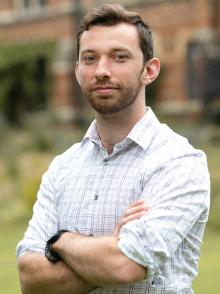NIH Oxford-Cambridge (OxCam) Scholar Mario Shammas received the honor of best oral presentation at this summer’s 2022 OxCam Colloquium for his talk, titled “Mitochondrial stress pathways in genetic forms of myopathy and neurodegeneration.” As part of his Ph.D. research, Mario uses a mouse model of a patient mutation that causes myopathy (a muscle disease) to study how mitochondria respond to stress. His work has implications for Parkinson's disease, amyotrophic lateral sclerosis (ALS), spinal muscular atrophy (SMA), and other debilitating conditions.
It wasn’t by chance that Mario selected a field relevant to Parkinson’s disease. In high school, he watched daily as his favorite teacher battled the early stages of Parkinson’s. His teacher’s struggles and resilience deeply affected Mario, and he promised that he would spend his life working on research that could help. This is Mario’s NINDS research experience so far as he keeps that promise to his teacher.

I knew before starting my Ph.D. that I wanted to work on Parkinson’s disease. That was also clear to my OxCam interviewers, one of whom was Dr. Michael Ward, Investigator in the NINDS Neurogenetics Branch. After hearing my story, he recommended that I speak to Dr. Derek Narendra, a Lasker Clinical Research Scholar and Investigator in the NINDS Inherited Movement Disorders Unit. Indeed, I found that Dr. Narendra’s interests and mine were very much aligned: understanding common neurological conditions by focusing on rare monogenic causes of these diseases. Roughly 85% of Parkinson’s is idiopathic, but 15% of cases have known genetic underpinnings. In the latter group of cases, we often know the exact gene and mutation causing the disease. We have, therefore, a causa prima—an unassailable starting point from which we can trace downstream pathways that lead to disease.
After that fruitful introduction, I joined Dr. Narendra’s group to study the paralogous mitochondrial proteins CHCHD2 and CHCHD10. Mutations in these proteins cause a variety of autosomal dominant diseases, including Parkinson’s, ALS-frontotemporal dementia (FTD), myopathy/cardiomyopathy, and an adult-onset form of SMA. I found these proteins fascinating because they allow us to tackle three questions of great significance for the field:
- What do the CHCHD2/CHCHD10-associated forms of neurodegenerative and myopathic diseases tell us about these diseases’ more prevalent idiopathic forms?
- How are different mutations on the same protein leading to differential tissue toxicity (for example in central nervous system versus muscle)?
- What are the shared mechanisms of disease downstream of these mutations, and do they hint at an underlying similarity among the prevalent forms of these diseases?
These are the questions that I have focused on during my time at NIH. Although it turned out to be difficult to model the Parkinson’s-associated mutation in the mouse, we generated mouse models of the myopathy/cardiomyopathy and ALS-FTD mutations. I was able to use those models to answer the above questions, as well as to elucidate the protective mechanisms through which mitochondria combat stress. These findings were published earlier this year in the Journal of Clinical Investigation. After completing my M.D. and Ph.D. training, I hope to specialize in neurology and continue researching monogenic causes of neurological disease.
Contributed by Shana R. Spindler, PhD
